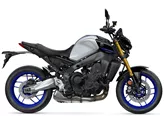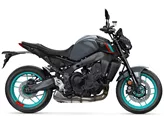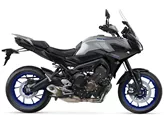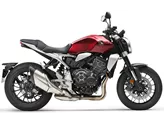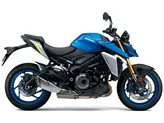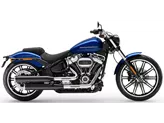Suzuki GSX-S750 2017 vs. Yamaha MT-09 2016

Suzuki GSX-S750 2017

Yamaha MT-09 2016
Vue d’ensemble - Suzuki GSX-S750 2017 vs Yamaha MT-09 2016
In terms of engine and drive train, both the Suzuki GSX-S750 2017 and the Yamaha MT-09 2016 have inline engines. However, the Suzuki GSX-S750 has a slightly lower engine power of 114 HP compared to the Yamaha MT-09's 115 HP. The torque of the Suzuki GSX-S750 is 81 Nm, while the Yamaha MT-09 has a torque of 87.5 Nm. The Suzuki GSX-S750 has 4 cylinders and a displacement of 749 ccm, while the Yamaha MT-09 has 3 cylinders and a displacement of 847 ccm.
In terms of suspension, the Suzuki GSX-S750 2017 has an upside-down telescopic fork for its front suspension, while the Yamaha MT-09 2016 has a telescopic fork. Both bikes have an aluminum frame with a twin tube frame type.
For the brakes, both bikes have double disk brakes at the front. The front tire width for both bikes is 120 mm, and the front tire diameter is 17 inches. The rear tire width is also the same for both bikes at 180 mm, with a rear tire diameter of 17 inches.

Suzuki GSX-S750 2017
In terms of dimensions and weights, the Suzuki GSX-S750 has a slightly longer wheelbase of 1455 mm compared to the Yamaha MT-09's 1440 mm. The seat height of the Suzuki GSX-S750 is 820 mm, while the Yamaha MT-09 has a slightly lower seat height of 815 mm. The kerb weight of the Suzuki GSX-S750 is 213 kg, while the Yamaha MT-09 is lighter at 188 kg.
Now let's compare the strengths of each bike. The Suzuki GSX-S750 2017 has a GSX-R 750 engine with a strong character, providing a powerful and thrilling riding experience. It also has powerful and well-controlled brakes, ensuring safety and control during braking. The harmonious design of the bike is visually appealing, and it comes at an affordable price compared to other bikes in its class. The sharp sound of the engine adds to the overall experience, and the bike offers great lean angle clearance for confident cornering.
On the other hand, the Yamaha MT-09 2016 has a wonderfully powerful three-cylinder powerplant, delivering impressive performance. It also offers three power modes, allowing riders to adjust the bike's performance to their preference. The fully adjustable chassis ensures a personalized and comfortable riding experience. The quickshifter as standard is a convenient feature for seamless gear changes. The sporty upright seating position provides a comfortable and engaging riding posture, and the bike has good brakes for reliable stopping power. The aggressive looks of the Yamaha MT-09 add to its appeal, and it comes with traction control for added safety.

Yamaha MT-09 2016
Now let's discuss the weaknesses of each bike. The Suzuki GSX-S750 2017 has an acute knee angle, which may be uncomfortable for some riders during long rides. Additionally, the tachometer on the bike may be difficult to read, which can be inconvenient while riding.
On the other hand, the Yamaha MT-09 2016 has a saddle that may be a little too hard for long tours, potentially causing discomfort for riders. The license plate holder on the swingarm also offers less splash protection compared to a conventional one, which may result in more dirt and water splashing onto the bike.
In conclusion, both the Suzuki GSX-S750 2017 and the Yamaha MT-09 2016 are powerful and capable naked bikes with their own strengths and weaknesses. The Suzuki GSX-S750 offers a strong character engine, well-controlled brakes, and an affordable price, while the Yamaha MT-09 boasts a powerful three-cylinder powerplant, adjustable chassis, and sporty seating position. Riders should consider their preferences and priorities to choose the bike that best suits their needs.
Caractéristiques techniques Suzuki GSX-S750 2017 par rapport à Yamaha MT-09 2016
Avantages et inconvénients en comparaison
Avantages et inconvénients en comparaison
Suzuki GSX-S750 2017

Plus de puissance, plus de performance, plus de son. Suzuki dément également tous les pessimistes concernant la norme EURO4 et livre avec la GSX-S 750 un successeur de la GSR 750 perfectionné à tous points de vue, qui peut être encore un peu plus sérieux, mais pas forcément. Pour que les moments d'ahurissement ne deviennent pas des moments d'oje, l'ABS et un contrôle de traction à trois niveaux désactivables offrent un coussin de sécurité. Avec des pneus S21 de Bridgestone, la GSX-S est supersport, ce qui permet de profiter de l'angle d'inclinaison maximum généreux. Seul l'angle du genou pointu pourrait avoir un effet négatif sur les longs trajets.
Yamaha MT-09 2016

La Yamaha MT-09 n'a pas eu besoin d'être réinventée pour la saison à venir - elle l'a déjà été extrêmement bien il y a à peine quatre ans. Au lieu de cela, les Japonais ont misé sur un réglage fin et l'ajout de gadgets pratiques, adaptés à l'époque, comme le contrôle de traction et le changement de vitesse automatique. La norme Euro4 a une fois de plus modifié la gestion du moteur qui, en mode standard, offre un développement de la puissance certes puissant, mais bien contrôlable. Le plus grand changement, reconnaissable au premier coup d'œil, est le design, à mon avis très réussi, avec l'avant plus agressif et l'arrière redessiné. Dans l'ensemble, il s'agit donc d'une naked bike encore plus élégante, qui a clairement été construite pour le plaisir de conduire une moto.
Comparaison des prix Prix moyen du marché Suzuki GSX-S750 vs Yamaha MT-09
There are a few key differences between a Suzuki GSX-S750 2017 and a Yamaha MT-09 2016. In terms of price, the actual average price of a Yamaha MT-09 2016 is about 3% higher. Compared to Yamaha MT-09 2016 there are more Suzuki GSX-S750 2017 bikes available on the 1000PS.de Marketplace, specifically 14 compared to 11. It takes less time to sell a Suzuki GSX-S750 with 84 days compared to 87 days for a Yamaha MT-09. Since model year 2017 1000PS.de editors have written 14 reviews for the Suzuki GSX-S750 and 57 reviews for the Yamaha MT-09 since model year 2013. The first review for the Suzuki GSX-S750 was published on 10/4/2016 and now has more than 50,800 views. This compares to more than 39,900 views for the first review on Yamaha MT-09 published on 6/10/2013.




